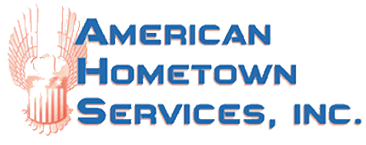Could there be something in your home that is making you and your family ill? There most certainly could be, and it is a substance that is found in almost every home and commonly known as mold. Mold is a type of fungus and scientists estimate that there are between 100,000 and 400,000 types of fungi that have previously been identified. Studies suggest that up to 1,000 different types of mold can be found growing in homes and businesses across the United States. Mold can be found in many different places within your home including bathrooms and kitchens, under sinks, behind or under appliances, around windows or areas where condensation is prone to collect, high humidly areas within your home, and even in drapery and carpets!
American Hometown Services has prepared the following guide to mold – as well as how to clean and remove it!
• Some types of mold are referred to as mildew.
• Mold can live indoors or outdoors and thrives in damp, warm and humid environments
• Allergic reactions are one of the most common health effects of mold and symptoms include:
o Rash
o Watery eyes
o Runny nose
o Itchy eyes
o Coughing
• More serious effects of mold exposure include:
o Muscle and joint pain
o Headache, anxiety, depression, memory loss and visual disturbances
o Weakened immune system and fatigue
o Shortness of breath
Mold can be classified into three groups:
• Allergenic mold
• Pathogenic mold
• Toxic mold
Household Mold Types; Identification & Removal
The most common types of household mold that can be found inside homes and businesses include: Cladosporium, Penicillium, Alternaria and Aspergillus. Stachybotrys chartarum also known as Stachybotrys atra and often referred to as “black mold” is a greenish-black mold that can be found in homes but is less common than other types of mold. Black mold grows on household surfaces that typically have high cellulose content such as wood, paper, dust and lint. Some types of mold grow on food and fabrics.
Reproducing Mold Spores in House & Air Lead to Allergies, Lung & Breathing Problems
Molds reproduce by forming tiny spores that are invisible to the naked eye. Mold spores are resilient and can survive under extreme conditions especially in dry environments. Spores can travel through indoor air and when a mold spore lands on a surface where any moisture is present, mold can start to grow and reproduce. Although shower stalls and sinks are typically moist areas that are prone to the growth of molds, any moist area within your home can be a breeding ground for mold spores. Drywall, ceiling tiles, carpets, furniture, ductwork, roofing, paneling, wallpaper, under sinks, and the areas around plumbing pipes are all examples of areas in your home that have the potential to become infected by mold spores especially if the right conditions are present. Mold spores in the outside air can enter your home through open doors, windows and vents and can also be brought into your home on clothing, shoes and pets.
Professional Mold Clean Up, Removal & Remediation in Quincy, Macomb, Hamilton, Warsaw, Hancock & East Alton Illinois | Hannibal, Missouri | Norman, Oklahoma
The bottom line is that damp areas in your home can be damaging to your health. The expert cleaning technicians at American Hometown Services can professionally clean your home to remove potentially dangerous mold spores before they have a chance to flourish and cause sickness and allergic reactions within your home. Contact American Hometown Services today and speak with a knowledgeable customer service technician about our customized housekeeping, restoration and mold remediation services.




